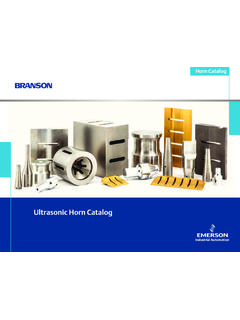Transcription of Joining Technologies for Plastics - Emerson
1 Joining Technologies for Plastics The perfect solution for every application Branson: The World's Major Resource for Plastics Joining Technologies . Branson is everywhere you need us to be for Plastics Joining . With technical facilities and sales/support offices throughout the Americas, Europe and Asia, our global perspective and local presence set us apart from the competition. We offer more Plastics Joining Technologies than anyone and can provide the process best suited for each application. Our unsurpassed industry experience helps you get to market quickly, with quality products manufactured with the highest efficiencies.
2 Manufacture in a single location? Design in Europe or the Americas with production in Asia? Branson works closely with you through every stage of a project, including consultation, design, material feasibility, prototype development, product testing and final production. We team with integrators and manufacturers, developing OEM equipment that can be installed seamlessly and integrated into automated systems. Our support services include employee training, engineering assistance, creating new/modified parts, troubleshooting, preventative maintenance and repair.
3 Branson can successfully meet your Plastics Joining challenge with our application experience, technical expertise and responsive service. The Widest Range of Plastics Joining Solutions Branson offers several Joining advanced Plastics Joining equipment, Following are the processes we Technologies without favoring one you can be confident in making the offer to meet a wide variety of technique over another. In each right choice. Plastics Joining applications. application, we review all parameters of the project with you to find the solution that provides the best performance.
4 Deciding factors include product specifications, functional demands, materials used, part size/. geometry, production quantities, automation and overall costs. With our technical expertise, experience with numerous polymers, and Ultrasonic welding In ultrasonic welding , high-frequency vibrations generate heat at the interface of the parts to be joined, melting the plastic and creating a strong bond. The technique is fast, efficient, non-contaminating and requires no consumables. It produces a clean weld site with highly uniform joint quality, providing exceptional performance, consistency, and reliability.
5 Easily integrated into automated systems, our equipment Ultrasonic welding is well suited for stud weld, degate, or spot weld can be readily customized to fit exact assembling parts with delicate thermoplastics, and slit or laminate specifications of welded parts. internal electronic components thermoplastic films and fabrics. and can be used to insert, stake, Vibration welding Vibration welding creates high-strength, leakproof hermetic seals with most thermoplastics and is useful for assembling irregularly shaped parts. The solid weld flash makes this technique attractive for industrial parts assembly.
6 It is economical and fast for high-volume production, and flexible for multiple tool changeouts in the same machine. The process creates friction/heat at the joint interface of the parts to be mated, until the right molten state is reached. The plastic then solidifies under clamping pressure and forms a permanent bond. In addition to linear vibration welding , only Branson offers orbital vibration technology, increasing joint welding opportunities to meet a wider range of requirements. Hybrid Process for Clean Vibration Joints Hybrid welding combines infrared and vibration processes, offering more options and applications for smart molding joint design.
7 Branson's innovative technology incorporates localized broadband infrared preheating into the vibration weld tooling. Proprietary metal foil emitters melt the joint area's surface before the vibration process starts, minimizing particles generated during the vibration weld phases and producing clean, high-strength joints, with reduced residual stresses, material-specific friction and welding time. Thermal welding Fully controlling plastic's ability to melt and flow into an extended shape, thermal welding enables molten plastic to capture another component, imbed an insert into a part, and connect a plastic part to other parts such as metal or glass-filled resins.
8 This process is gentle and won't damage fragile components. Its uses include heat staking, insertion, swaging, degating, and date stamping. Spin welding Spin welding is ideal for Joining thermoplastics where the part-to-part interface is round. The process brings the part interfaces together, under pressure, with a circular motion. Frictional heat is generated, causing the joint area to melt and fuse together into a strong, hermetic seal. Spin welding is highly economical, relatively quiet, adaptable to automation, and provides fast cycle times. Infrared welding Infrared welding , a non-contact assembly method, uses localized radiant heat from contour-adopted, broadband metal foil emitters to melt the mating surfaces of the parts to be assembled.
9 This permits greater freedom in designing parts such as complex curved joints and internal walls. The technique produces strong, airtight welds with a solid, homogeneous bead and very good flash quality. Compatible with most thermoplastics, infrared welding is particularly appropriate for higher-temperatures processing, and is effective on semi-crystalline resins such as polyethylene and polypropylene. In addition, the infrared heat source is precisely controlled, important when dealing with heat-sensitive parts. Hot Plate welding Hot plate welding utilizes a heated platen that directly contacts the mating surfaces of the parts to be joined.
10 This technique is cost-effective and compatible with most thermoplastics. Greater latitude in parts design is possible, since the hot plate method can weld parts and internal walls, and assemble thin-wall parts, complex geometries, large/multiple small parts and parts with loose internal components. Laser welding Laser welding joins materials not easily welded by other thermal assembly methods. This innovative technique is based on the STTIr (Simultaneous Through Transmission Infrared) principle, where laser energy passes through one plastic component and is absorbed by the second component.
















